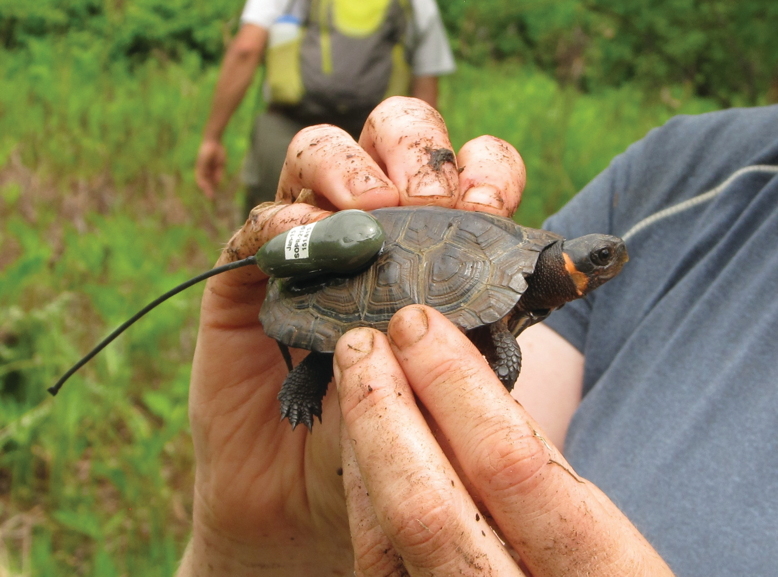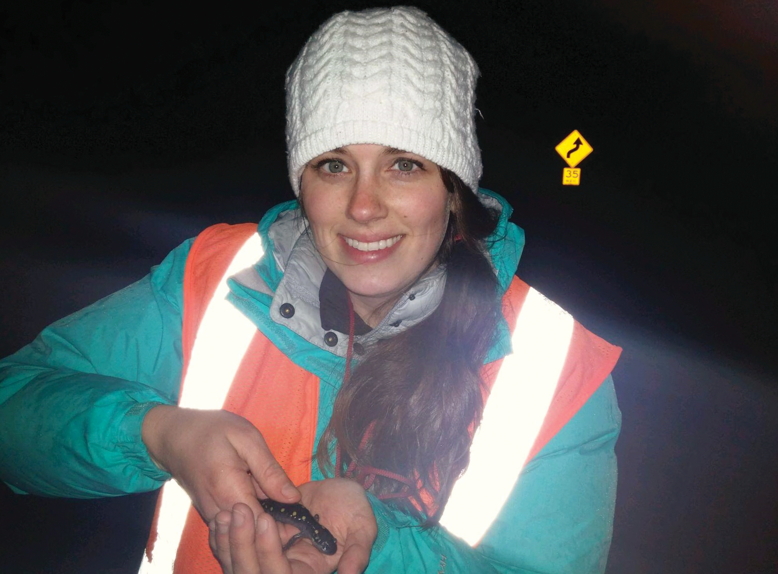Some forms of habitat enhancement and management seem to go against human instinct. The habitat of the golden-winged warbler, whose breeding population was recently listed as endangered, generally follows the eastern side of the Appalachian Trail in northern New Jersey. The bird needs young forest habitat to thrive, but in New Jersey, our forests are all fairly old.
“In New Jersey, all of our forests are 60 to 100 years old because in the 1880s, the forests were destroyed through agriculture or for fuel,” Triece says. “Since then, we’ve started preserving land…but because of that, they’re all the same age.”
Triece says young forests occur after natural disturbances like fires or floods. But humans act to stop such natural occurrences. In this situation, controlled burns or the cutting of trees can be used to create an open canopy—acts that are sometimes deemed controversial, even amongst conservationists.
Habitat management and restoration work go hand in hand. Invasive plants like phragmites, reed canary grass and Japanese barberry all commonly take over the wetland habitats of the endangered bog turtle. To help the species, biologists attempt to control the invasive plants and reintroduce native flora.

Biologists affix radio transmitters to endangered bog turtles in southern New Jersey to track their every move. Photo courtesy of Brittany Dobrzyinski.
Conservation groups and state agencies often work together to achieve common goals. New Jersey Audubon, for example, recently helped to pass an amendment to the state Constitution to permanently allocate 4 percent of the state’s corporate business tax—or about $80 million annually—for land preservation and stewardship of open space. However, enabling legislation was vetoed by Governor Chris Christie. It will likely take a future governor to facilitate implementation.
Once implemented, “we will have consistent, pay-as-you-go open-space funding so that we can strategically invest in preservation and habitat restoration,” says Mooij.
Some of New Jersey Audubon’s biologists recently partnered with the ENSP on a project to track newfound and unrecorded bog turtles living in freshwater wetlands in Salem County. To better understand the endangered species, the biologists affixed radio transmitters to four turtles and so far have found that the turtles reside in small patches of land no bigger than half an acre. Determining which habitat the turtles find favorable will allow the land to be properly managed in hopes that the turtle numbers there can increase.
New Jersey Audubon biologists also work on shorebird banding alongside ex-ENSP chief Niles, who coleads the Delaware Bay Shorebird Project. The goal is to collect data on and track shorebirds like the red knot, ruddy turnstones and semipalmated sandpipers, among others.
Niles worked over the past few years to restore vital habitat for red knots and other shorebirds both in the bay and on the Atlantic coast. On the bay, he and his team—in partnership with New Jersey Audubon, the American Littoral Society and CWF—have helped restore the habitat of six vital sites stretching over two miles of beach, where the landscape was diminished.
Volunteers also help to supplement an array of projects across the state. Triece, of CWF, runs the volunteer-based Amphibian Crossing Project in North Jersey. Dozens of volunteers show up on rainy nights in mid to late March to help amphibians cross the road—literally.
“In one night, on one transect of road maybe 50 to 100 meters long, we might get 2,000 amphibians,” she says. “So we’ve recruited volunteers to basically walk up and down the road to collect data on the species and the time, and we record temperature and weather so we can quantify what’s going on at that site.”

Biologist Kelly Triece
This past spring, on Waterloo Road in Byram Township, site of the proposed crossing tunnel, volunteers assisted the safe crossing of 1,432 amphibians, including spotted salamanders, which are currently recommended to be listed as a species of special concern.
A similar project takes place every summer in South Jersey, where about a dozen volunteers patrol roads to help protect northern diamondback terrapins which are also being considered for the species-of-special-concern list.
With so many challenges, environmental workers are buoyed by their success stories, such as the comeback of New Jersey’s bald eagle population. The species was down to one nesting pair in the early 1980s, due largely to DDT use; today, thanks to an aggressive protection and reintroduction initiative, the population is stable, with 161 nesting pairs. The horseshoe crab moratorium is another state conservation win.
Hope also exists in a $1.3 billion federally funded conservation plan offered by a blue ribbon panel assembled by the Association of Fish and Wildlife Agencies (AFWA). The panel, made up of politicians, representatives from environmental groups, academic researchers, business executives and members of the oil industry, has called on Congress to “dedicate up to $1.3 billion annually in existing revenue from the development of energy and mineral resources on federal lands and waters to the Wildlife Conservation Restoration Program.”
A plan like that, Jenkins says, could mean as much as $25 million—about 10 times the ENSP’s current budget—coming into the state for conservation.
For now, volunteers are doing their part in whatever way they can to support state efforts and conservation groups. Gail Hill of Bucks County, Pennsylvania, recruited volunteers and traveled more than two hours to take part in the reTURN the Favor program to rescue horseshoe crabs in the Delaware Bay.
Hill, who is director naturalist of the Peace Valley Nature Center in Pennsylvania, says she enjoys volunteering with conservation projects wherever she can. “Next time we come, we’ll probably bring half the neighbors in the state,” she laughs. “It’s just the coolest thing—we’re really excited about it.”
